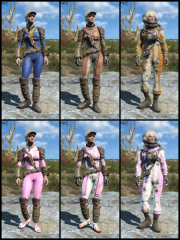DOWNLOAD MODS
Are you looking for something shiny for your load order? We have many exclusive mods and resources you won't find anywhere else. Start your search now...

-
Posts
101 -
Joined
-
Last visited
-
Days Won
5
Content Type
Profiles
Forums
Downloads
Tutorials
Gallery
Store
Events
Everything posted by RabidGears
-
Try setting up relative paths in Nifskope (Options->Settings...->Resources->Auto Detect Game Paths). You're currently using absolute paths for the textures, which may be causing the problem. They should show up as "textures\clutter\dwwoodmetalstrip02.dds" and "textures\clutter\dwwoodmetalstrip02_n.dds" in BSShaderTextureSet. I tried out your nif and it works fine when using relative paths.
-
Congrats! I can't wait to see how it turns out.
-

Pick up dead corpses of humans and creatures
RabidGears replied to TheObserver's topic in Skyrim Mods
Well, the most obvious thing you could do is study those other mods to see how they do things. -
That thread Grond posted has good info on what you need. It's the specular map that's stored in the alpha channel of the normal map that controls the shininess. For meshes with metal bits you may also need an environment map . This is used for reflections and makes the metal bits look more realistic. Some good examples of this in use are the the heavy armors, like Steel Plate (nordplate) or the pauldrons on the Dawnguard armor. Also, when you're editing your mesh in Nifskope, pay special attention to the settings in BSLightingShaderProperty, because they also have an influence on both specular and environmental lighting.
-
Hmm, I think maybe using another distro might be the way to go. I wish I could recommend Arch, but installing it is way too much for someone who's new to Linux. But maybe a distro from the Arch family, like Manjaro, could work. I've heard of people using it as an easy way to install Arch then modifying it to turn it back into vanilla Arch.
-
I can't find much Ubuntu specific information on this that's recent and for this specific hardware setup, so we'll have to try the instructions from the Arch wiki. If I understand it correctly, everything that's needed should already be installed, and all that needs to be done is to configure it. You need to open up a terminal (the commandline thing) and run a few commands. Post the output of these here, because we need it to do the next part. This command should tell if the APU is actually being used instead of the Radeon card. (If it shows the radeon card then I've gotten everything wrong ) glxinfo | grep "OpenGL renderer" Then run this command. It should list all the cards on the computer, but it might only list the APU so don't worry if that happens. xrandr --listproviders Edit: You actually need to install mesa-utils to run the first command. sudo apt install mesa-utils
-
-
You can probably theme Unity to look differently too. I stopped using Ubuntu before Unity came along so I don't know that much about it, but I've themed GTK+ desktops (like GNOME, LXDE,...) quite a bit. It's surprising how much you can do with a good theme. If you're that worried about how it looks then learn how to use a build-it-yourself distro like Arch. You can install whatever you like then and make it look and function exactly how you like it. It's probably best to start with something like Ubuntu, though, so that you can learn what bits you like and don't like first.
-
I wasn't talking about that. ladyonthemoon mentioned that she was going to use an older distro with an older kernel that worked with the Catalyst drivers. Sorry about that. I should use quotes more. Ubuntu is fine. I don't personally like it, but it should run easily on that hardware. As should Mint. It's just this particular case of drivers for an AMD laptop. If you have an Intel/Nvidia setup then things are a bit better. Also desktops have less problems than laptops. It is well supported. I used Ubuntu when I was starting off too. If you don't like how the UI looks, then there are other flavours of Ubuntu available with different UIs. These are still the same Ubuntu underneath, though, so they will work exactly the same.
-
If you have Win 7 then it's best to dual boot. Using a VM for stuff like games isn't a good solution in my experience. Anyway, if the drivers don't work in Linux then they still won't work in a VM run on Linux. I also don't think it's a great idea to use old distros. Kernel updates are needed to fix exploits that crop up from time to time. Recently, there was a TCP exploit that has just been fixed in a recent kernel update. On the driver front: it looks like the Catalyst driver is now dead. AMD are now concentrating their new driver, AMDGPU, which only supports newer cards (not yours, unfortunately). They are, however, contributing to the open source driver. I've read some claims that this has good performance now, and even matches the catalyst drivers. I can't say if that's true, but I think you should give it a try. On the GPU switching issue: You need PRIME to implement GPU switching for AMD cards. How you set this up will depend on the distro you choose. Here's the Arch Linux wiki article: https://wiki.archlinux.org/index.php/PRIME I still recommend going with Linux Mint Mate edition and trying the open source drivers. Whatever you decide, though, I hope this helps.
-
As you said in the shoutbox, it does look like the official AMD drivers don't work with the recent versions of Linux Mint and Ubuntu. I don't know if this will change any time soon. Linux Mint comes with open source drivers, though, that should at least get the card to work. I assume by your hardware that this is for a laptop. I'm not sure about the specifics of AMD laptops but it's probably similar to what I've had to deal with on mine (Intel/NVidia). Laptop graphics cards work a little differently to desktops. They use hybrid graphics where the dedicated graphics card is only switched on when it is needed, so it doesn't waste power. Unfortunately, this feature is not well implemented for either Nvidia or AMD official drivers in Linux, but it can be accomplished with third party software. Linux Mint Cinnamon uses the Cinnamon desktop which I think needs hardware acceleration. I'm *assuming* that the radeon card isn't being turned on, and that could be the reason why Cinnamon won't work properly. The open source drivers that Mint comes with should at least be enough to run Cinnamon. I recommend using Linux Mint Mate which uses the Mate desktop. It doesn't use hardware acceleration, so it doesn't need the dedicated card turned on just to run the desktop environment. It's also more lightweight so it will run a bit better than Cinnamon. If that works then you need to find software that lets you run the dedicated card when you need it. For NVidia cards there's Bumblebee. I don't know for sure if there's an AMD equivalent but there must be. I'll have a dig around to see if I can find anything.
-
Welcome to TESA, Devestational! Like ladyonthemoon said, we all started off with no experience. If you're interested in modding, which it sounds like you are, then you'll pick it up. It's not as difficult as it seems. And there's always someone around who can help you if you get stuck on something. Have fun with it. Before long you'll be creating those followers that you're dreaming of.
-
If you can download it and it doesn't seem to be corrupted then the copy on the site is fine. Plus, you would still need the authors permission to upload it anywhere.
-
It's fine if the polys are triangles. The exporter doesn't mess it up, so converting to quads isn't necessary. @SpikeDragonLord, it would help if we knew exactly what you are trying to do.
-
Could you give a bit more information about what you're doing (i.e. did you import the initial model or make it from scratch)? Also, if it is Blender you're using, is it 2.49? When importing a model into Blender 2.49, if the model has any verts in the exact same location, these will get merged together. I get around this issue by using Blender 2.7 with the newer import scripts, to import the model, then save it as a .blend in legacy format so that I can open it in 2.49. I don't think there's an issue with exporting, at least from my experience, although it can't hurt to check your export settings if you're still having issues. If you're using Max or Maya, then I assume that the same issue is at play there.
-
Someone had a similar problem here, which they say was caused by a missing ini file. Maybe try reinstalling.
-
Is that the exact message? Because there's no filename, just the .nif extension.
-
Yes, I think it would be a good idea to start with deleting the eyes and mouth. It might also be a good idea to replace the eyes with eye sockets like the way vanilla head meshes are done. I'm pretty sure that you need to make all the morphs again from the nif, otherwise you may run into vertex order issues. The way I always do TRIs is: - Import my finished NIF into Nifskope - Export it as an OBJ - Duplicate that OBJ for each morph, giving them the appropriate morph names - Create the TRI - Import TRI into Blender to edit the morphs Using this method I've never had any issues with TRIs. You can quickly test out a new TRI by only editing one of the morphs just to make sure that it works properly in the CK.
- 11 replies
-
The Blender plugin is for Blender 2.49. It doesn't work with the newest version of Blender. I'm pretty sure that the eyeballs and inside of the mouth should not be part of the head mesh. They should have their own separate NIFs and TRIs. The issue that I mentioned before looks like the eye rims (or whatever they're called) of each eye are getting stretched over to the other eye, with part of them clipping through the eye balls in the process. This happens in most of the morphs, but not all of them. Apart from that, though, the morphs look fine to me and shouldn't cause the issues that appear in that screenshot. Maybe try making a fresh record to test out your new tri just in case the CK is refusing to recognise the new one.
- 11 replies
-
Why not just upload your mods to another site that hosts mods? You could upload them here, for instance.





